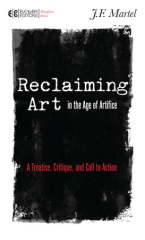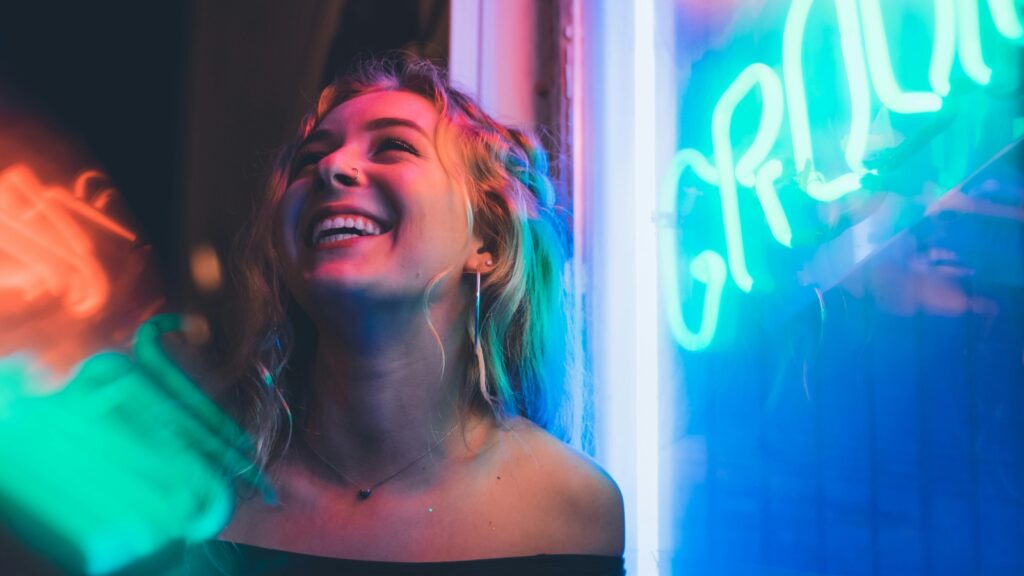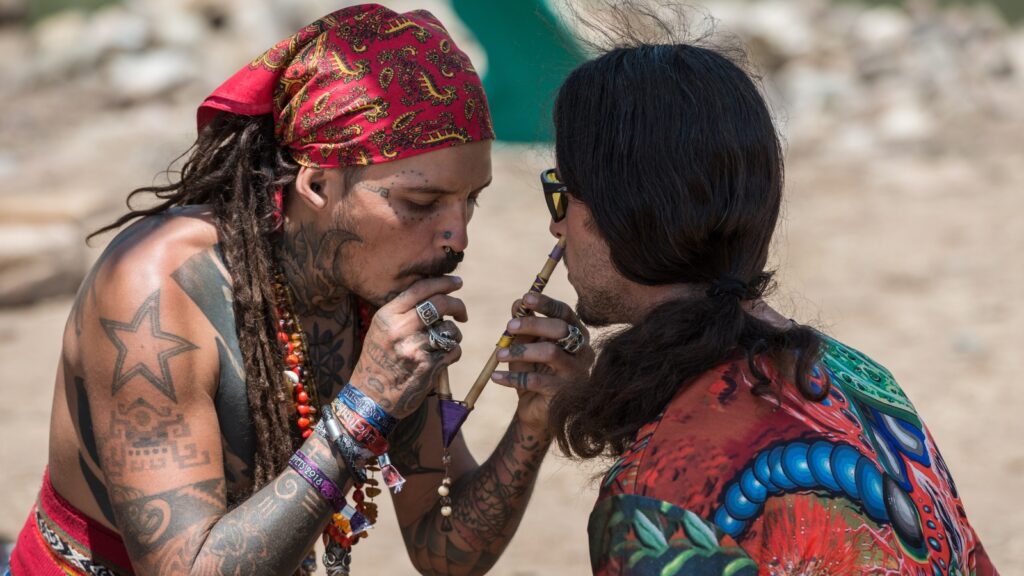J.F. Martel’s new book, Reclaiming Art in the Age of Artifice: A Treatise, a Critique, and Call to Action (Evolver Editions/North Atlantic Books), is a powerful invocation to return to what is arguably art’s central purpose, “to call us back to the source.” Disrupt what we take for granted to be true, and put us in contact with something greater, truer – something numinous.
Between us and the Mystery of all mysteries is the imagination, which is powerful enough to take us into the Otherworld, or other worlds, in daytime revery, vivid dreams, psychedelic experiences or other altered states. In our interview. J.F. describes how art can become a portal into the Otherworld, serving to disrupt the onslaught of “spiritual exhaustion” caused by the technological commodification of human culture and consciousness. You can read an excerpt from Reclaiming Art in the Age of Artifice here.
J: Your book’s subtitle refers to it as a “call to action.” What do you hope to inspire people to do?
JF: We’re inundated today with media that’s been carefully crafted to steer our emotions and the thoughts that follow from them. I’m thinking here of everything from advertising and political spectacle to software and product design. Reclaiming Art proposes that we make a conscious effort, if not to liberate ourselves entirely from this kind of media (which may well be impossible), then at least to recognize the value of aesthetic experiences that deepen our connection to the real instead of locking us up in an ideology. For artists who read the book, there’s a more concrete exhortation to heed their inner visions rather than sacrificing them to market forces or moral imperatives.
Why do we need to “reclaim art?” What is it that needs to be reclaimed?
The title of the book appears to say that art is something humans “had” at one point in history and need to find again. And there is a limited sense in which it does say that. On the other hand, I doubt we could point to a past society that didn’t try to appropriate and redirect art and artists in some way. This is because the real power of the work of art necessarily manifests in the field of direct experience. Society, by contrast, is almost exclusively concerned with mediating experience, thereby rendering it indirect. To put it differently, art is about unveiling the real while society exists as a kind of enclosure to protect us from the real. My hope is that by the end of the book, the reader will see that it’s in each of our lives that the reclamation of art needs to happen. Everyone has had at least one artistic encounter that changed them profoundly. This book is about recognizing the value of such experiences and exploring what they’re made of.
Which contemporary works of art are the best examples of how art should operate in the world?
My intention with the book wasn’t to write about how art should or shouldn’t operate, but rather to discuss what works of art do that nothing else can do. I think that there’s great art being made all the time in every medium. Some mediums—I’m thinking of cinema in particular—are especially difficult to create in because they require lots of middle-people and money, both of which tend to work against the realization of anything original or interesting. Every great film that actually gets made is a small miracle.
At the moment, I’m rereading several of J. G. Ballard’s novels and stories for an essay I’m working on. Ballard’s work is truly oracular. It allows us to see deeply into the play of forces behind the present age. Another artist that comes to mind is Kim Cascone, the San Francisco-based electronic composer. A lot of his work explores how a limited number of aesthetic elements can come together to form a complete world in the listener’s imagination. It gives off that powerful “sense of place” that David Lynch—another great artist, and one Cascone has worked with in the past—says is the mark of authentic art. Finally, I recently discovered the work of Canadian aboriginal artist Amanda Strong. She’s making some of the most deep-reaching visual art I’ve seen in a while. I could go on, but I’ll stop there.
In your book, you say that humans didn’t invent art, but rather art invented humanity. How do you mean?
The earliest examples of art, which go back some forty thousand years, are almost devoid of human figures. There are a few exceptions, most notably the famous Venus figurines found across Eurasia. But even these, with their exaggerated features and lack of a face, are only vaguely human. Clearly, representing human beings wasn’t a priority for our earliest ancestors. That’s extremely peculiar when you think about it. What I take from it is that the birth of the artistic imagination preceded the development of any kind of differentiated self-awareness in the species—anything that could be called “humanity.” The artistic imagination, which I believe lies not only behind art as such but also behind shamanism, magic and religion, had to be there as a sort of mirror in which we could gradually make out our reflection.
What is the difference between art and artifice, and why does it matter?
Artifice denotes the use of aesthetics to manipulate the emotions in a predetermined manner. In A Portrait of the Artist as a Young Man, James Joyce calls it “improper art” and defines it as art that presents its content in such a way as to induce a state of attraction or repulsion. There are therefore two kinds of artifice. Examples of the first kind include porn videos, advertisements and generic pop songs. All of these are, at bottom, pornographic. The second kind includes traditional propaganda films and shock art, but also any work specifically designed to push a political or social message: slick PSAs, moral fables and concept art that does nothing but voice an artist’s opinion.
What Joyce calls “proper art,” on the other hand, uses the aesthetic to reveal things in their original, preconceptual “suchness.” That is, it doesn’t reduce its content to some instrumental end. In doing this, artists end up producing symbols, beacons that point to those vast regions of reality which psychoanalysts call the unconscious. In other words, art doesn’t belong to the conscious world. It belongs on the same plane as dreams, visions and synchronicity. By its nature it calls us out of the trance states that artifice instills.
A society without art would be a totally artificial society in which people would lack the most effective means to envision realities beyond the ideological horizon. Yet in its zeal to reduce, tag, measure and quantify everything, contemporary culture is actively eliminating any distinction between art and artifice. Many if not most people today have bought into the idea that art is a cultural construct that’s completely subjective and devoid of intrinsic value. They are aware of artifice but dismiss art as a romantic delusion. This isn’t surprising, since capitalism will not become universal until it has gained absolute control of the human imagination.
Do the subjects of works of art need to be overtly spiritual, mystical, psychedelic, etc. to be any of those things? Does calling something Visionary Art make it visionary?
No. In fact works of art designed specifically to communicate spiritual ideas tend to lose the affective power that makes art what it is. This is something Gilles Deleuze develops in his philosophy. Art, he says, has nothing to do with concepts, opinions or ideas in the conventional sense. Rather, it inheres in the creation of sensations, either completely new sensations or sensations stripped of the clichés and assumptions that reduce them to stock feelings in normal reality. Art reveals the world before the development of concepts, including spiritual concepts.
The real power of a work of art doesn’t lie in its subject matter but in the style in which that subject matter is delivered. It’s in an artist’s style, in her unique perspective, that mystery is disclosed and forces that transcend the human world are revealed. This doesn’t mean that overtly mystical works can’t be visionary. It means that whatever visionary quality they have won’t come from the message they’re trying to communicate.
Take a gothic cathedral, for instance. Its affective power doesn’t depend on your understanding the meaning of every shape, angle, statue or picture. It comes from the aesthetic arrangement of the whole. You could be completely ignorant of Christian doctrine, even an atheist, and still feel the aura of sacredness that the place exudes. This is in part because the sacred has nothing to do with Christianity itself. You could get a similar experience in a mosque or a concert hall. All great works of art have a quality that exceeds their conceptual signification. This excessive quality, which explains how a thirteenth century building could be as meaningful today as it was when it was built, is what I attribute to the Imaginal in the book.
What is the “Imaginal” and how is it important for creating art? Is it any different than the human imagination?
In the book I use the term “imaginal” loosely in the sense that the French scholar Henri Corbin did in his study of Islamic mysticism. Corbin describes the imaginal world as an intermediary between Heaven and Earth, man and God. It’s the place of dreams, daimons and archetypes—what Carl Jung referred to as the collective unconscious. Having said that, I don’t believe that reality is actually divided into levels or realms. So when I speak of the Imaginal or the “otherworld” in my book, I’m talking about this world seen through a particular lens, or perhaps no lens at all. I equate the Imaginal with what Jung, at the end of his career, called the Unus Mundus, the “one world” that exists beyond the brain’s division of it into outer and inner, psyche and matter, past and future, and so on.
You quote William Gibson’s Pattern Recognition in your book: “Souls can’t be moved that quickly, and are left behind.” How has technology alienated us from ourselves, and can technology become more than an impediment for soulful expression?
I use that quote from Gibson to illustrate how modern technology can serve to disconnect us from the earth and the body. With transhumanism gaining traction even in the mainstream, it’s hardly a secret anymore that much of modern technology involves a rejection of the body, of subjective forms of time, of slowness, cyclicity, idleness, dream and play. What’s more, every technological device or process is, quite literally, someone’s opinion in material form. While technology can be useful, when it takes over entire environments it can become a screen closing us off to the non-human world. To exist in an entirely artificial, humanized environment is tantamount to being trapped in someone else’s head.
The Swedish occultist Thomas Karlsson speaks of “fatigue” as the most prevalent disease of our times. What he means by this is a spiritual exhaustion that comes from being perpetually immersed conceptual environments and media. Think of the listlessness you feel after watching TV or scrolling down your Facebook timeline for a couple of hours. I think spiritual fatigue is most definitely an impediment to soulful expression. Karlsson recommends regular contact with nature, which is free of concepts. I agree and include art in the things that qualify as nature. You don’t come back from a great play or a concert drained. You come back energized and refreshed, as if you went for a walk in the woods.
Does art have to be beautiful? What is beauty, anyway, and who decides what makes something beautiful?
In the book I define beauty as the quality we attribute to things when we see them for what they really are. I’m in agreement with the medieval theologians who conceived it as a fundamental attribute of the universe, but one that humans get to only by peeling away the layers of judgment and projection that cloud their vision. On the other hand, I don’t agree with the traditional Western view that beauty necessarily involves harmony or perfection. Rather, true beauty is always somewhat disconcerting. It points to a secret order in the universe that the human mind couldn’t fully take in without being transformed or destroyed. This form of beauty exists everywhere in nature, including that part of nature we call art. I think that under the right circumstances, anyone—not just Monet or Van Gogh—could see the weirdness that hides in a sunrise or a sunflower.
How can art make a political and social difference today? Or in other words: how can we create art that actively combats the commodification of human consciousness?
Art is in itself a form of resistance to the commodification of consciousness. Every bit of time and energy spent creating or experiencing works of art escapes the grasp of those forces that would reduce us all to a quantity or algorithm.
In a sense, asking what art should do to improve society is like asking what the heart should do to improve the health of the body. The heart can only do one thing: beat. It’s up to the body to live in such a way as to allow it to keep beating. Similarly, the only thing art can do is reveal the non-human forces that shape the world. It oxygenates society by infusing it with a more expansive reality than its preconceptions, opinions or beliefs allow for. Art is the heartbeat of a civilization. For that reason, it’s not up to artists to produce works that will change the world. It’s up to the world to organize itself in such a way that artists are able to make the art they’re called to make. While this doesn’t absolve artists of their civil responsibilities as members of society, it does mean that when they practice their art, they ought to have the freedom to be guided by powers that exceed our understanding. True works of art are powerful symbolic constructs, genuine oracles that can give society access to what’s going on below the threshold of collective consciousness. But they won’t do that if artists feel a need to impose a moral or message on the material. For the magic to happen, vision must lead the way.
David Metcalfe’s The Message provides two variations on a theme for Reclaiming Art
Teaser image by William Blake: “Urizen with the Book” courtesy of Creative Commons License










